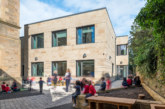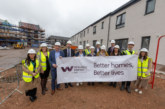Edinburgh may not be the biggest city in the UK, but Scotland’s capital is incredibly beautiful and diverse. Alongside financial services and a booming tourist industry, Edinburgh is leading the way in technological innovation. However, not everyone in the city is benefitting from the city’s growth.
Edinburgh is one of the least affordable places to live in the UK, with many people struggling to afford to buy or rent a home. Claire Clutten travelled up to Scotland to speak to Housing and Economy Convener, Cllr Kate Campbell, to find out how The City of Edinburgh Council is tackling the supply and affordability challenge head on, through the introduction of initiatives such as Edinburgh Living and Housing First.

In August 2018, the six local authorities that make up the Edinburgh and South East Scotland region; along with regional universities, colleges and the business and third sector signed up to a £3.1bn City Region deal with the Scottish and UK Governments to deliver transformational change to the city regional economy. A key element of this is building more homes and accelerating delivery of strategic housing sites in the region; including Edinburgh’s Waterfront, where there is capacity to deliver more than 4,000 new homes.
The City of Edinburgh Council’s Housing and Economy Convener, Cllr Kate Campbell, comments: “One of the key issues for us, and I think it is an economic development as much as it is a social issue, is housing. In Edinburgh, we have one of the most expensive property markets in the UK. An average two-bed rental flat in Edinburgh costs over £1,000 a month. In order to meet the needs of our workforce and wider population, we need to increase the supply of affordable housing.”
Kate continues: “The Council has an incredibly ambitious housebuilding programme. We have made a pledge to build 20,000 affordable homes over the next 10 years, which is going to be a very big challenge for us. In order for us to deliver on that ambition, we need more financial support from government and we need to find new and innovative ways to work with industry and partners. The City Region Deal provides a framework for taking this forward.”

Edinburgh Living
One of the ways the City of Edinburgh Council is looking to create more affordable homes is establishing a new partnership with Scottish Futures Trust. The new partnership called ‘Edinburgh Living’ will own and manage homes for mid market and market rent.
As part of its commitment to ‘increasing and accelerating housing supply’, the Scottish Government has approved funding to facilitate Edinburgh Living. Housing Minister Kevin Stewart, who opened the first development of new homes to be built through the initiative in January of this year, elaborates: “We’re supporting the industry and local authorities to deliver housing priorities with quality homes that fit individual and community needs. That’s why we were keen to support the City of Edinburgh Council in their efforts to develop Edinburgh Living.
“Through the City Region Deal, we have approved a funding package comprised of on-lending consents up to £248m and a one-off capital grant of £16.1m to enable the Council to establish Edinburgh Living as a Housing partnership, which will deliver a minimum of 1,500 homes at mid-market rent and market rent levels.”
The first homes to be delivered through the partnership have been built in Clermiston in the north west of the city. The 44-home scheme, which opened in January, includes 22 properties for mid-market rent, targeting households on low to moderate incomes, and 22 houses which will be retained by the Council for social rent.
The scheme, like all of the Council’s housing developments, is tenure blind and the properties, built by Robertson Partnership Homes, meet the Silver Standard for energy efficiency.
Kate says: “Edinburgh Living gives us another way to build much needed, additional affordable housing and also allows us to take forward Council-led regeneration, delivering mid rent and market rent homes alongside other tenures. But we don’t just want to build houses, we want to build high quality homes that will be easy to heat, where people feel safe and where tenants will have an excellent quality of life.
“The homes at Clermiston are beautiful. There’s been a real effort to provide the things people want and need — drying greens, storage and a terraced landscape gardens which will be a brilliant place for kids to play.”
Christa Reekie, Commercial Director at the Scottish Futures Trust adds: “This innovative partnership marks a huge step forward in increasing the supply of high quality and energy-efficient homes for rent in various locations around the city for many years to come.”

New housing
The City of Edinburgh Council and its housing association partners currently have around 2,000 affordable homes under construction on various sites across the city. The Council itself has 3,000 homes in design development but in order to meet its 20,000 affordable homes target, it will need to acquire more sites. In 2018, the Council purchased a former gasworks site in the Edinburgh Waterfront; increasing its landholdings in the area to over 120 acres. This has created an opportunity to deliver co-ordinated housing led regeneration with benefits that will extend into surrounding communities and the city region. A major consultation exercise is underway to produce a development framework and delivery masterplan for the area.
Kate says: “You can’t just impose that many homes somewhere and expect it to work, that’s why we’re consulting with the community on what is important to them and what they would like to see developed.”
The new development will also involve an element of masterplanning and see improvements to the seafront and promenade at Granton.
The Council has a long established partnership with housing associations across the city. Kate says: “We have an Affordable Housing Policy in the city which provides land for housing associations to build affordable homes. Around 5,000 of planned affordable housing completions over the next five years are expected to be on private sector land through the AHP.”
Kate says: “In Scotland the Scottish Government gives grant funding directly to RSLs, except in Glasgow and Edinburgh, where we as local authorities manage grant funding on behalf of government. This enables us to co-ordinate the delivery of land and investment.”

Tackling homelessness
At the sharp end of housing need is people who are homeless or at risk of homelessness. Addressing homelessness is a major challenge in a growing city with a lower proportion of social rented homes than other local authority areas.
Kate says: “We let 70% of council social homes to people experiencing homelessness (more than any other local authority in Scotland) and have people living in temporary accommodation for 18 months or longer. Preventing homelessness is a priority for us but we know people are becoming homeless because they simply can’t afford to pay the rent or mortgage. It is difficult to prevent that without increasing the supply of affordable homes.
“We are also committed to ending the use of bed and breakfast for homeless families and are working with housing association partners to implement ‘Housing First’ in Edinburgh.”
The nationwide ‘Housing First’ programme, supported by funding from Social Bite and Scottish Government, aims to provide housing and support for vulnerable homeless people. Social Bite runs social enterprise cafes across Scotland, including in Edinburgh, and has raised funds to help homeless people.

Housing pressure
Kate says: “Increasing the supply of new affordable homes is not the only challenge that we face in Edinburgh. Alongside investing in new homes we need to improve the quality of existing homes.”
The Council has an existing stock of around 20,000 homes but around half of those homes are in blocks where the Council is not a majority owner.
Kate says: “We have a rolling kitchens and bathrooms upgrade programme, and are installing new heating systems and making properties more energy-efficient, which is part of the Scottish Housing Quality Standard. We are looking to invest more than £500m in our housing stock over the next 10 years. This will include improvements to common areas of buildings which will involve supporting owners to invest in their homes.”
Another issue that the Council is seeking to address is concerns regarding the use of short-term lets in the city. “We had a report at our corporate policy & strategy committee asking the Scottish Government to allow us the power to regulate short-term lets. There are tenements in the Old Town in which there are just one or two permanent residents with the rest of the flats being used as short-term lets. This impacts on people’s sense of community and their sense of safety.
“The Scottish Government acknowledges the issues that we have and is working with us to look at a regulatory framework that would enable us to respond to the concerns of local residents.”
In a place where the demand for more affordable homes of all tenures is bourgeoning, and there is a need to continually invest in an incredibly diverse housing stock — ranging from Victorian tenements to post war housing — the Council certainly has a job to do. With the help of government funding, willing partners and innovative thinking, aligned with a strong will to reform elements of the housing market that are not working for the people of Edinburgh, the Council is in a good position to deliver on its housing ambitions.
Header image: Edinburgh’s Waterfront, about to undergo major regeneration, from the air © Aerial Photography Solutions









